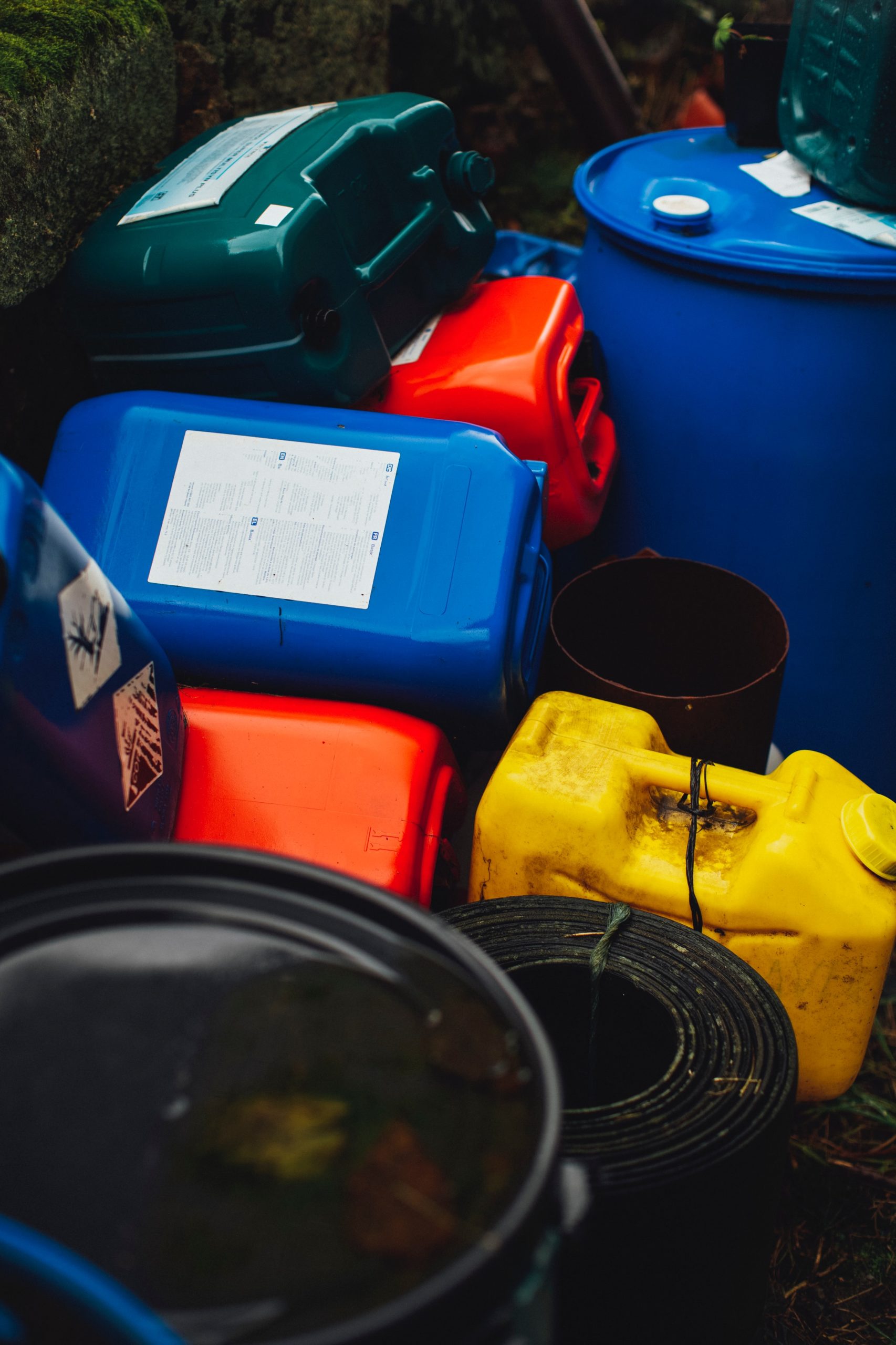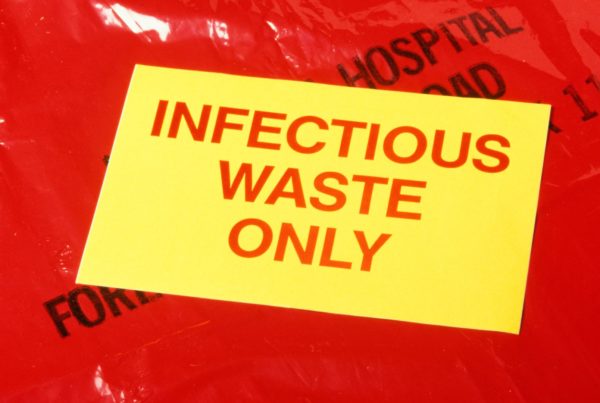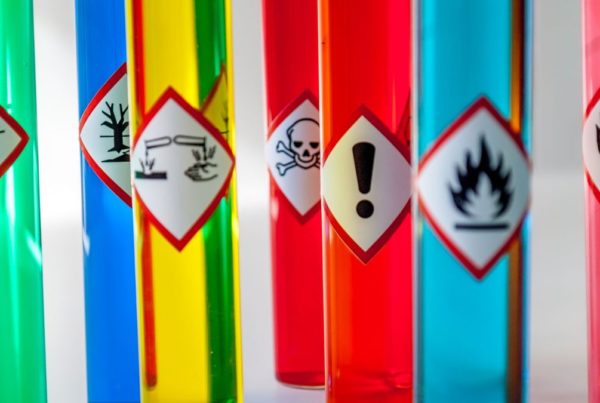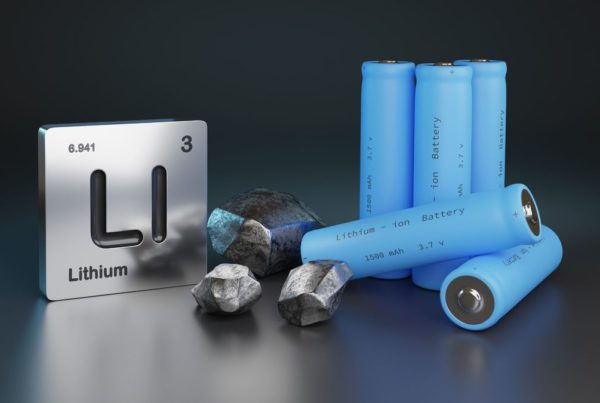Storing hazardous materials correctly is an extremely important part of hazardous waste management. Not only does correct storage help to prevent toxic spills, fires, and injuries, but you could land a hefty fine from the Environmental Protection Agency (EPA) if you fail to follow the relevant laws. It’s important to understand:
- Laws pertaining to the storage of hazardous waste
- Categories of waste generators
- Required hazardous waste storage areas
- Quantity and time limits for hazardous waste storage
- How your hazardous waste should be packaged
- How to avoid hazardous waste storage violations
Please note that this guide covers federal requirements. You will need to familiarize yourself with your state-specific requirements to ensure that you remain compliant with the law.
Relevant Hazardous Waste Regulations
At a federal level, hazardous waste storage is regulated under the Resource Conservation and Recovery Act (RCRA). The practices of each waste generator must comply with the requirements listed in Title 40 of the Code of Federal Regulations, specifically those listed in part 264 for permitted facilities and part 265 for interim status facilities.
Individual states also have regulations for HAZMAT storage that waste generators need to fulfill. While these localized regulations are allowed to be more stringent than the federal ones, they are not allowed to be more lenient. The best way to find out what your state requires as far as hazardous waste storage is to refer to the map provided by the EPA.
Generator Status
To implement the federal regulations for hazardous waste management, the EPA established a system that classifies waste generators according to the volume of waste they create. The initial three classifications were originally published in 1985. These were later updated on November 28, 2016, in the Generator Improvements Rule.
Very Small Quantity Generator (VSQG)
Previously known as “conditionally exempt small quantity generators,” the VSQG category includes those who produce:
- Up to 100 kg of non-acute hazardous waste each month
- Up to 1 kg of acute hazardous waste each month
- Up to 100 kg of spill residue from acute hazardous waste
Small Quantity Generator (SQG)
SQGs include facilities that produce:
- 100 to 1000 kg of non-acute hazardous waste each month
- Up to 1 kg of acute hazardous waste each month
- Up to 100 kg of spill residue from acute hazardous waste
Large Quantity Generator (LQG)
LQGs include facilities that produce:
- Over 1000 kg of non-acute hazardous waste each month
- Over 1 kg of acute hazardous waste each month
- Over 200 kg of spill residue from acute hazardous waste
Large Waste Generators Have the Most Requirements
Whereas large quantity generators are subject to the full set of requirements listed in Part 262.17, small-quantity generators only need to meet some of these requirements. Very small quantity generators are exempt from regulation as long as they comply with Section 260.10.
What about Facilities with Several Buildings?
A facility that has several contiguous buildings and areas of land that all belong to the same owner is considered a single waste generator by the state. Therefore, a small laboratory or greenhouse that is part of a larger complex might need to abide by LQG requirements even if it produces very little hazardous waste.
What If You Exceed the Limit?
It’s possible that a facility might change its generator status from month to month. This might occur if production is higher in certain months and you pass the waste volume threshold. If this happens, your status will change to match the highest volume of hazardous waste produced. You will then stay in that category for the rest of the calendar year.
Hazardous Waste Storage Areas
According to regulatory requirements, HAZMAT waste generators need two storage areas for their waste: a satellite accumulation area and a main hazardous waste storage area.
Satellite Accumulation Area
At the site where the waste is produced, owners need to establish a satellite accumulation area. This is the place where the hazardous waste will be collected in the short term for transfer to the main storage area or transported to appropriate disposal facilities. Because the satellite accumulation area should be easily accessible, it should be located in the same building as the waste process, at most a “frisbee throw” away.
The satellite accumulation area must comply with these rules:
- Containers must be sealed all the time, except when adding more waste.
- Containers must be labeled with the words “HAZARDOUS WASTE” and the kind of hazardous waste they contain — for example, “Class 8 corrosive,” “Class A flammable,” or “Class B reactive.”
- Containers must be dated to make sure they are removed from the area within 72 hours and taken to either a disposal facility or the main storage area.
- The limit for satellite accumulation is 55 gallons of hazardous waste or one quart of acute hazardous waste.
Main Hazardous Waste Storage Area
The main hazardous waste storage area is where you will keep your labeled containers of waste until they are transported to their ultimate destination. The way in which this waste must be stored is the same for generators of every size. However, different time and quantity limits apply depending on your generator category.
Appropriate Hazardous Waste Storage Containers
Made from a Compatible Material
Each hazardous waste container must be made of a material that is compatible with the type of waste it contains. For example, a corrosive liquid must be stored in a container that won’t corrode and a flammable liquid must be stored in a container that won’t ignite. The container must not have any leaks or be dirtied with waste residue on the outside.
Sealed with a Lid
The containers used for liquid hazardous waste must have a tight-sealing lid to prevent the contents from leaking or spilling out. A screw-type lid is ideal for this purchase. Funnels, aluminum foil, plastic bags, and plastic wrap are unacceptable substitutes for lids. Containers holding hazardous waste must be closed at all times during storage except when adding or removing waste.
Correctly Labeled
Each hazardous waste container must be labeled with a hazardous chemical waste tag from the first moment it is used to collect waste. These tags must include:
- The phrase: “HAZARDOUS WASTE” in capital letters
- The instruction: “Federal Law Prohibits Improper Disposal. If found, contact the nearest police or public safety authority or the U.S. Environmental Protection Agency.”
- The EPA ID number, name, and address of the generator
- The state-relevant EPA waste number, if relevant
- The accumulation start date
- The hazardous waste manifest tracking number
- The nature of the contents (liquid, solid, hazard classification)
- A list of the exact contents of the container
- A statement that identifies the primary hazard
All of the labels used in your facility should be consistent, and you should maintain detailed records of all hazardous waste that is stored. Someone at the facility must also be designated to conduct weekly inspections of the main hazardous waste storage area and log these inspections in a book.
If the contents of a container change, the tag must also be updated to reflect the new content. Any old labels on the container that are no longer relevant must be defaced. You can get matching tags through a hazardous waste management program such as the one offered by GAIACA.
The Hazardous Waste Storage Area
The area where the containers are to be stored must also meet several requirements to protect human health and the environment:
- The storage area should be isolated.
- The hazardous wastes must be surrounded with secondary containment to prevent any spills from running into a sink, hood, or floor drain.
- Incompatible hazardous wastes (such as acids and bases) must be separated to prevent a chemical reaction. Separation can be achieved with separate cabinets or hoods or by placing the containers in separate secondary containment tubs.
Which Hazardous Wastes Can Be Mixed
There may be some situations in which the quantity of a hazardous liquid is too small to justify its own container. If this happens, you must pay attention to chemical compatibility, the nature of each substance, and how mixing chemicals will affect their final disposal.
A few key points to note:
- Mixing hazardous waste with non-hazardous waste renders the entire container hazardous.
- Mixing incompatible hazardous materials could cause an explosion or generate toxic gas.
- Mixing hazardous wastes that require a different treatment during disposal will make recycling difficult and costly (if not impossible).
In a small cannabis-extraction facility, for example, you could mix butane, propane, ethanol, and isopropyl alcohol (all of which are Category 2 flammable liquids according to OSHA), and glycerin with vegetable oil (both Category 4 flammable liquids according to OSHA). Dry ice (U.N Hazard Class 9 – miscellaneous) cannot be added to either mixture because it belongs to a different hazard class.
How Much Hazardous Waste You Can Store
Hazardous wastes are subject to limits depending on the facility’s status:
- Very small quantity generators may store up to 1000 kg or 2,200 lbs of non-acute hazardous waste, 1 kg of acute hazardous waste, or 100 kg of acute hazardous waste spill residue.
- Small quantity generators may store up to 6000 kg or 13,200 lbs of non-acute hazardous waste, 1 kg of acute hazardous waste, or 100 kg of acute hazardous waste spill residue.
- Large quantity generators have no limitation on the amount of hazardous waste they can store.
Time Limits on Hazardous Waste Storage
Just like quantity, the amount of time you can keep hazardous wastes on-site depends on the facility’s status:
- VSQ generators have no time limit provided that they don’t exceed the quantities stated above.
- SQ generators can store hazardous wastes for up to 180 days, or up to 270 days if the nearest hazardous waste disposal facility is more than 270 miles away.
- LQ generators can store hazardous wastes for up to 90 days. If they want to store hazardous waste for longer than 90 days, they will need to obtain a permit to become a hazardous waste storage facility.
Hazardous Waste Storage Violations
Facilities managing hazardous waste are responsible for following all of the relevant laws. If you are found to be in violation of these laws, you might be subject to fines from the EPA. The most common violations when it comes to hazardous waste storage include:
- Storing wastes incorrectly
- Mixing different waste types in the same container
- Holding wastes in either of the two storage areas for longer than the time limits
- Accumulating more hazardous waste than is permitted by your generator status
Once you are familiar with the regulations regarding hazardous waste generation and storage and implement appropriate policies, you should remain in good standing with the EPA.
Ensure Compliance with Professional Hazardous Waste Management
For many small and large quantity generators, it makes sense to invest in third-party hazardous waste management services to ensure that all of the boxes have been ticked. These companies can provide everything you need to get started, including containers, labels, secondary containment solutions, and more.
While it may seem like a lot of work, correct hazardous waste storage will help you to protect your workers and the surrounding environment and prevent costly spills and fires. Ultimately, hazardous waste management is a necessary part of running a cannabis business, and doing things right will save you money down the road.






